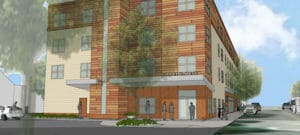Top Story
Name: Ethan Boxer-Macomber
Company: Anew Development
City: Portland, Maine
Product Types: Market-rate and affordable multifamily housing with commercial aspects
What did you do before you were a developer?
I was a municipal planner in Davis, California, right out of graduate school at UC Davis. Then my wife and I relocated back to my home state of Maine. I got another municipal planning job here in Portland, Maine, and after about three years I took my first position in real estate development with a nonprofit, where I worked for about seven years. I was able to build a network, learn the trade, work on over a dozen large-scale affordable housing projects, and got my feet underneath me.
What motivated you to make the leap into development?
As an urban planner, I was motivated to see my community evolve to be less auto-dependent, more physically and socially cohesive, and stronger economically. It became clear to me that it was the developers in our community that had the most control over how our community was changing—their ability to direct capital investment and influence design.
As an independent, self-employed developer, I now have the autonomy and flexibility to have a more direct and effective influence on positive change through both the projects I bring forth and by participating in the dialogue with other developers.
Does your smart growth–oriented approach complicate your work with communities?

Ethan took a decommissioned elementary school (originally 18,000 SF) that was a drain on the community and provided a plan to adaptively reuse the building for the benefit of South Portland, Maine.
No, quite the opposite. I find when I approach communities, whether I’m talking with adjacent neighbors or elected officials, the idea of doing quality infill development and increasing urban vitality is, by and large, very well received. Most people intuitively understand and agree with smart-growth principles.
Where do you turn to get a fresh perspective on or experienced insight into a prospective or existing deal?
I spend a lot of time online. I subscribe to a lot of groups’ newsletters. There are great conferences by local planning associations, and I try to stay engaged with local planning changes. So when local planning initiatives are in play, I often get engaged. It’s important to stay fresh on technology and how we design our buildings, too.
What does being a successful real estate developer mean to you?
For me, it’s that the project provides an end benefit to the surrounding community, the end users, those who occupy it. It’s about generating jobs and property tax, bringing people closer together socially, and bolstering patronage to local businesses. So I look at it very comprehensively. Three and a half years into my business, I’ve still only fully completed one project, but Meetinghouse Lofts is a great example.

Emphasizing smart-growth goals of historic preservation, context sensitive design, and sustainable design, the redevelopment of The Roosevelt School into 19 moderately priced condominiums provides an ideal location for residents to walk or bike to nearby shops, restaurants, and services such as doctors’ offices and community recreation facilities.
Could you tell me more about Meetinghouse Lofts and how that exemplifies what you want to do?
It was an old elementary school in South Portland, Maine. It’s a turn-of-the-century, brick schoolhouse that the city had decommissioned. The building had become a liability to the city: it was a challenge for them to heat in the winter, police, and maintain, and they weren’t getting any tax revenue for it. Furthermore, it became a point of ill will for the neighbors who had to live around it in its blighted condition.
At the same time, the school—like many from the turn of the century—was built right in the center of a neighborhood commercial node where you have banks, doctors’ offices, a corner store, restaurants—a vibrant, amenity-rich neighborhood.
I was able to go in there and adaptively reuse the school building. It went from being a blight on the neighborhood to one of the most enhancing pieces in the neighborhood. Property values immediately went up all over the neighborhood. Those abutting the property were immediately celebrating what we’d done there. From the city’s perspective, the building went from being a liability to an asset. Now Meetinghouse Lofts is a community asset, and it’s generating new property tax.
It took about $5 million in contracting to redesign and build, and we hired all local people to do that, so for a year or two we were hiring a lot of people from right there in the community. In doing this, we followed National Park Service guidelines for historic preservation, so we created a shining example of how a historic resource should be preserved. We actually won two awards for that—one at the local and one at the state level.
Finally, we moved folks in—who by and large were in retirement age, people looking to
downsize and simplify their lifestyles. They moved in and they formed an exceptionally wonderful community. They’ve developed great friendships, and they’ve found real support and kindness in one another. And what didn’t occur to me until later is that by relocating here, they freed up 19 single-family homes elsewhere, so there’s more inventory out there for people looking for a larger home.
In the end, the project really presented a win/win scenario for all involved and affected. Frankly, it would have been much easier to develop 19 newly constructed, freestanding units somewhere out on a greenfield, but it wouldn’t have been nearly as rewarding.
Why was this the first project? It seems like a really big first project.
[laughs] Everyone always says that. . . . You know, with my former employer, we developed projects that were typically 30 or 40 units. The scale was quite large. Some were as many as 60 units. To me, Meetinghouse Lofts felt more like a a small project. I think that was a real benefit of working for a nonprofit developer first: they trained me to work big and not to be afraid of going big.
I know a lot of people with similar entrepreneurial aspirations, and their first projects are typically two or three units. I was just fortunate enough to receive great training beforehand and to be able to translate that to the project.
What skills or traits do you think are most important to make the leap into real estate development?
It’s funny—that was one of the first questions I asked one of my mentors. His answer was perseverance, and I said, “No, seriously.” [chuckles] But I’ve found in my time that that is it. You are told “No” constantly. It can beat up your psyche. It can beat up your ego. What we’ve found is that our conversations have moved toward, “Don’t tell us ‘No,’ tell us ‘Not yet,'” and we ask, ‘Where do we need to be to get there?’
It’s about self-awareness. If you go into deals and you don’t know where you are and you believe that you are more important than you are, or if you undervalue yourself, then you’re going to leave something on the table. It’s very important to recognize who you are and what you’re bringing to each deal.
In looking at the next one to two years, what do you see as the biggest challenges to your business and projects?
I can name the two biggest risks going forward with Anew Development pretty easily.
The first is the turmoil going on in our national government right now. So much of what developers do is banking on what will happen five or more years out, and we have to be able to count on economic and political stability. As a developer, it’s kind of terrifying to think that we could go to war or interest rates could spike or tax policies drastically change, and all those things have big impact on the thin margins that we already deal with.
The second one that makes me lose sleep is the growth pressures on cities as we reurbanize. Here in Portland, we have very little crime, clean air and water; we’re surrounded by beautiful natural amenities, and we’re rich in historic structures, hospitals, restaurants, and art. But, it’s resulting in growth pressure. It’s getting hard to find a building to buy anymore because the speculative prices have gone wild. When that happens, I think we become susceptible to deep-pocketed investors from away coming in who are less concerned with the community benefit of projects and who are willing to cut corners to optimize profit.
If I can manage a risk factor, it doesn’t concern me much. But uncontrollable externalities like these are what keep me up at night.
Have any of these factors affected your projects?
Yes. When the current administration expressed that they were going to be seeking ways to deeply reduce the corporate tax rate, the market for the housing tax credits went from about 96 cents on the dollar to about 84 cents. The housing tax credit is all based on a market for these credits, and investors are all buying the credit because they’re going to use it to get a ten-year return on the tax credit. If all the sudden they’re told that their tax obligation is going to be reduced by other means, then the market for that credit becomes greatly diminished.
It caused show-stopper funding gaps on all of my projects. Luckily, we’ve resurrected all three of the projects, but not without a lot of sleepless nights.
What was a memorable mistake?
Probably the biggest one I’ve made so far: assuming a certain-sized construction loan and then rounding out my financial sources on a deal while assuming that my appraisal would support what I wanted to do. I had gotten loans before, but the banks were so well protected by submarket rents that were supporting the affordable housing projects that I had done before.

Anew Development has other projects in the pipeline, including 62 Spring Street in Auburn, Maine, a 41-unit rental project with ground floor retail set to break ground in the summer of 2017. The City believes this will be a catalytic investment in a neighborhood that was largely deconstructed during the period of urban renewal.
In the end, the amount I could borrow from a bank was considerably lower than I expected, and the amount of private equity I needed to raise was significantly greater. There was a lot on the line.
In the three projects that I’ve started since then, of course, appraisal’s the first part of the conversation with the bank [laughs]. So, I learned from that one! I learned that developers look forward, and appraisers look backward.
About Entrepreneur Profiles
Entrepreneur Profiles are conversations with real estate development professionals who, in most cases, have recently made the leap into the industry whether as young individuals fresh out of school or as mid-career transitions.
With a focus on small-scale developers often doing incremental and transformative work, these are quick and easy to read profiles to raise awareness of these professionals. By telling their stories, the Urban Land Institute hopes to inspire the next generation of small scale entrepreneurs to transform their own communities. See the most recent Entrepreneur Profiles.



